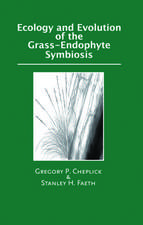Lake Kariba: A Man-Made Tropical Ecosystem in Central Africa: Monographiae Biologicae, cartea 24
Editat de E.K. Balon, A.G. Cocheen Limba Engleză Paperback – 9 feb 2012
Din seria Monographiae Biologicae
- 24%
 Preț: 2612.51 lei
Preț: 2612.51 lei - 18%
 Preț: 948.92 lei
Preț: 948.92 lei - 15%
 Preț: 648.74 lei
Preț: 648.74 lei -
 Preț: 397.59 lei
Preț: 397.59 lei - 28%
 Preț: 91.90 lei
Preț: 91.90 lei -
 Preț: 379.86 lei
Preț: 379.86 lei -
 Preț: 388.34 lei
Preț: 388.34 lei -
 Preț: 414.91 lei
Preț: 414.91 lei -
 Preț: 395.47 lei
Preț: 395.47 lei -
 Preț: 389.49 lei
Preț: 389.49 lei -
 Preț: 401.24 lei
Preț: 401.24 lei -
 Preț: 394.71 lei
Preț: 394.71 lei -
 Preț: 405.99 lei
Preț: 405.99 lei -
 Preț: 425.84 lei
Preț: 425.84 lei -
 Preț: 381.21 lei
Preț: 381.21 lei -
 Preț: 389.56 lei
Preț: 389.56 lei - 18%
 Preț: 1833.65 lei
Preț: 1833.65 lei - 18%
 Preț: 1230.35 lei
Preț: 1230.35 lei - 18%
 Preț: 1027.08 lei
Preț: 1027.08 lei -
 Preț: 399.67 lei
Preț: 399.67 lei - 18%
 Preț: 2493.72 lei
Preț: 2493.72 lei -
 Preț: 404.89 lei
Preț: 404.89 lei - 20%
 Preț: 557.46 lei
Preț: 557.46 lei -
 Preț: 418.76 lei
Preț: 418.76 lei -
 Preț: 408.37 lei
Preț: 408.37 lei - 15%
 Preț: 650.69 lei
Preț: 650.69 lei - 15%
 Preț: 652.31 lei
Preț: 652.31 lei -
 Preț: 395.37 lei
Preț: 395.37 lei - 18%
 Preț: 1232.26 lei
Preț: 1232.26 lei - 15%
 Preț: 637.59 lei
Preț: 637.59 lei - 18%
 Preț: 1231.95 lei
Preț: 1231.95 lei - 18%
 Preț: 1226.90 lei
Preț: 1226.90 lei - 15%
 Preț: 658.22 lei
Preț: 658.22 lei -
 Preț: 353.75 lei
Preț: 353.75 lei - 18%
 Preț: 1224.36 lei
Preț: 1224.36 lei -
 Preț: 386.22 lei
Preț: 386.22 lei - 20%
 Preț: 723.22 lei
Preț: 723.22 lei - 15%
 Preț: 652.49 lei
Preț: 652.49 lei - 18%
 Preț: 1228.62 lei
Preț: 1228.62 lei - 18%
 Preț: 945.30 lei
Preț: 945.30 lei - 18%
 Preț: 1231.64 lei
Preț: 1231.64 lei - 15%
 Preț: 633.68 lei
Preț: 633.68 lei - 20%
 Preț: 572.09 lei
Preț: 572.09 lei - 18%
 Preț: 1844.54 lei
Preț: 1844.54 lei -
 Preț: 386.61 lei
Preț: 386.61 lei
Preț: 417.59 lei
Nou
Puncte Express: 626
Preț estimativ în valută:
79.91€ • 86.78$ • 67.13£
79.91€ • 86.78$ • 67.13£
Carte tipărită la comandă
Livrare economică 22 aprilie-06 mai
Preluare comenzi: 021 569.72.76
Specificații
ISBN-13: 9789401023368
ISBN-10: 9401023360
Pagini: 808
Ilustrații: 779 p.
Dimensiuni: 155 x 235 x 42 mm
Greutate: 1.11 kg
Ediția:Softcover reprint of the original 1st ed. 1974
Editura: SPRINGER NETHERLANDS
Colecția Springer
Seria Monographiae Biologicae
Locul publicării:Dordrecht, Netherlands
ISBN-10: 9401023360
Pagini: 808
Ilustrații: 779 p.
Dimensiuni: 155 x 235 x 42 mm
Greutate: 1.11 kg
Ediția:Softcover reprint of the original 1st ed. 1974
Editura: SPRINGER NETHERLANDS
Colecția Springer
Seria Monographiae Biologicae
Locul publicării:Dordrecht, Netherlands
Public țintă
ResearchCuprins
General Contents.- I Limnological Study of a Tropical Reservoir by A. G. Coche.- of Part I.- and Acknowledgements.- Section I The Zambezi catchment above the Kariba Dam: general physical background.- 1. Physiography.- 2. Geology and soils.- 3. Climate.- 4. Flora, fauna and human population.- Section II The rivers and their characteristics.- 5. The Zambezi River.- 6. Secondary rivers in the lake catchment.- Section III Lake Kariba physico-chemical characteristics.- 7. Hydrology.- 8. Morphometry and morphology.- 9. Sampling methodology.- 10. Optical properties.- 11. Thermal properties.- 12. Dissolved gases.- 13. Mineral content.- Section IV Conclusions.- 14. General trophic status of Lake Kariba with particular reference to fish production.- Literature cited.- Annex I.- Annex II.- II Fish Production of a Tropical Ecosystem by E. K. Balon1.- of Part II.- A Parable.- 1. Introduction and acknowledgements.- 2. Methods.- 3. Age and growth studies.- 4. Total production, available production and yield of major fish taxa from Lake Kariba.- 5. The eels.- 6. Fish production of the drainage area and the influence of ecosystem changes on fish distribution.- 7. The success and failure of the clupeid introduction.- Concluding discussion.- Epilogue.- Literature cited.- Appendix A. List of symbols used.- Appendix B. Efficiency of rotenone-cove samples by G. P. Bazigos.- Appendix C. Tables of mean sizes of individual species, life intervals and growth intensity.- Appendix D. Tables of individual species and single sample production computations.- Appendix E. Morphometry of sampling sites and standing crop tables.- Appendix F. Time of annulus inception: a pond experiment by E. K. Balon & E. M. Chadwick.- Appendix G. Lepidological study: Key scales of Lake Kariba fishes.- III Plates: An Annotated Photographic Summary of the Lake Kariba Ecosystem.- General Index.














